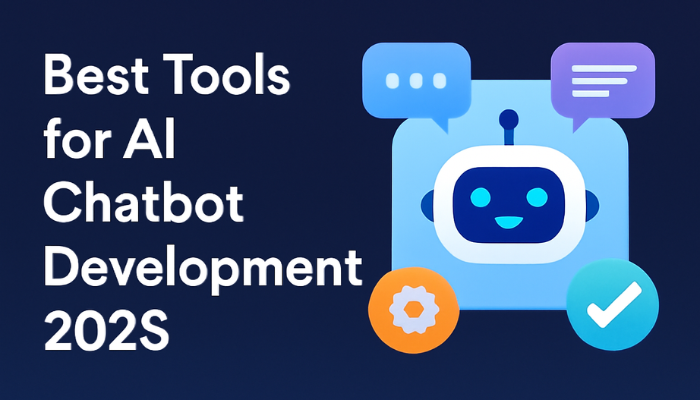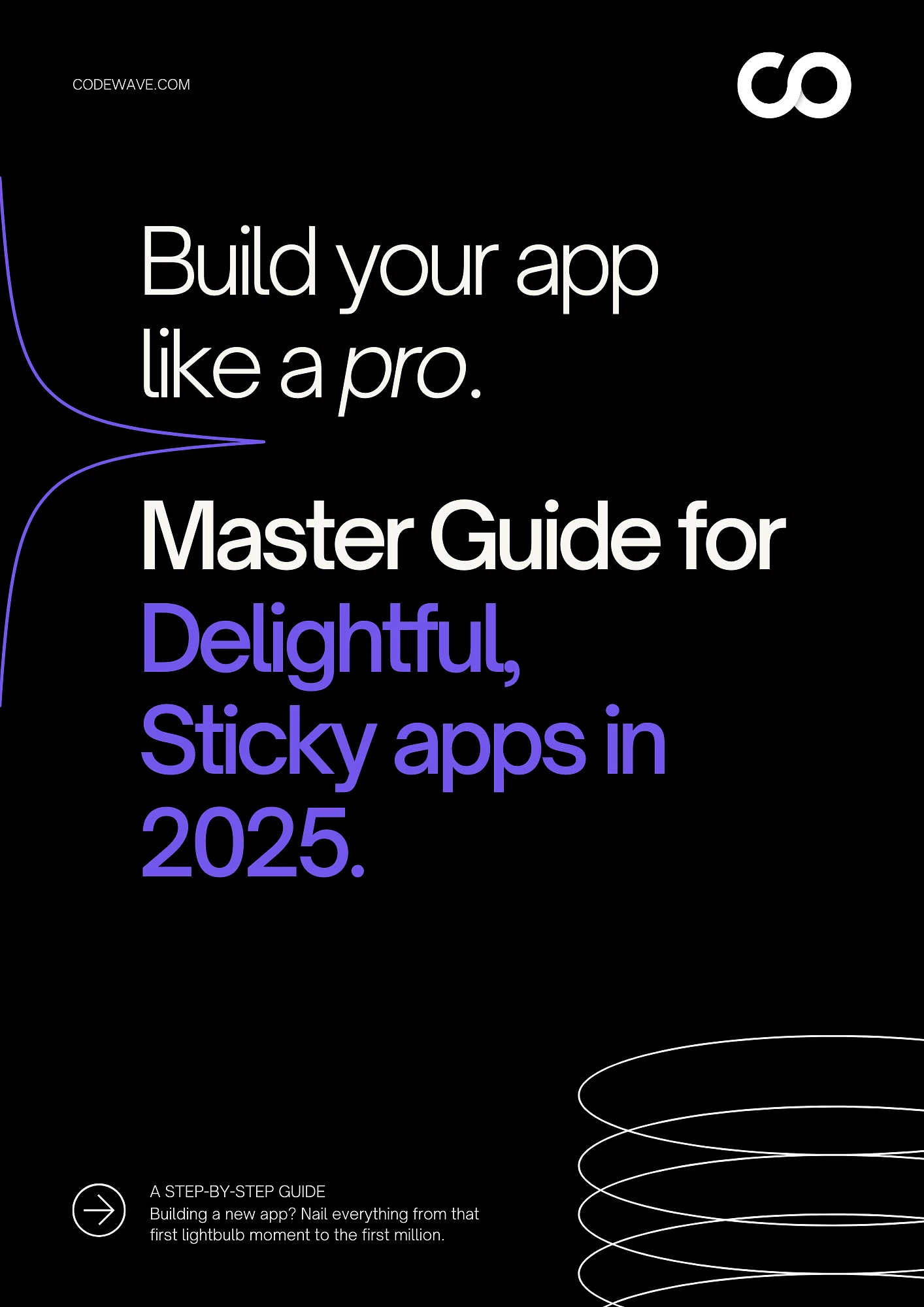Remember when chatbots were just simple scripts that could barely understand “hello”? Those days are long gone. Today’s AI chatbots are conversational powerhouses that can handle complex customer queries, book appointments, process orders, and even crack jokes that actually land.
The AI chatbot market has exploded in 2025, with businesses across every industry scrambling to deploy intelligent virtual assistants. From small startups to Fortune 500 companies, everyone wants a piece of the chatbot revolution. And why wouldn’t they? These digital assistants work 24/7, never take sick days, and can handle thousands of conversations simultaneously.
But here’s the thing, building an effective AI chatbot isn’t just about having a great idea anymore. It’s about choosing the right development tools that can turn your vision into reality without breaking the bank or your sanity.
In this blog, we’ll walk you through our top picks for the best tools for AI chatbot development in 2025, helping you make an informed decision and get your chatbot up and running in no time.
TL;DR – Key Takeaways
- Picking the right tool is the difference between a chatbot that works and one that struggles.
- We’ll explore the best platforms like OpenAI, Dialogflow, and Rasa—each offering something special.
- We’ll cover what really matters in chatbot tools—things like ease of use, language skills, and how easily it connects with other systems.
- At Codewave, we build chatbots that are smart, easy to use, and work perfectly with your business systems.
Why Your Tool Choice Makes or Breaks Your Chatbot
Think of chatbot development tools as the foundation of your digital assistant. Pick the wrong foundation, and your chatbot might end up being that awkward conversationalist who responds to “How’s the weather?” with “I can help you place an order.” Choose wisely, and you’ll have a smooth-talking AI that users actually enjoy interacting with.
The stakes are higher than ever. Users expect ChatGPT-level intelligence, instant responses, and seamless integration across platforms. Whether you’re a coding wizard or someone who thinks HTML is a sandwich ingredient, there’s a tool out there that can help you build the chatbot of your dreams.
Also Read: Top Open Source Chatbot Frameworks to Use
Ready to discover which tools are leading the pack in 2025? Let’s dive in.
Top Tools for AI Chatbot Development in Australia
Explore the leading tools for AI chatbot development in Australia. From powerful frameworks to advanced natural language processing (NLP) platforms, discover the best solutions that can help you build smarter, more efficient chatbots.
1. OpenAI GPT-4
OpenAI’s GPT-4 is a state-of-the-art language model known for its impressive conversational abilities. By understanding and generating human-like text, it’s designed to handle complex conversations and provide relevant, accurate responses in real-time. As one of the most powerful models available, it’s widely adopted across industries for chatbot development, virtual assistants, and beyond.
Key Features:
- Deep Contextual Understanding: GPT-4 doesn’t just respond based on individual queries; it maintains context over multiple exchanges, making interactions feel fluid and natural.
- High-Precision Responses: Thanks to its vast training data, GPT-4 provides accurate and well-rounded answers, making it ideal for tasks that require detailed knowledge.
- Multilingual Capability: GPT-4 can understand and respond in multiple languages, which is invaluable for global businesses needing a chatbot that can cater to diverse markets.
- Customizable Behavior and Tone: GPT-4 can be fine-tuned to match the desired conversational style or tone of your brand, whether formal, friendly, or casual, ensuring it aligns with your business’s personality.
- Advanced Problem-Solving Abilities: It can assist with more than just answering questions—it can help users solve problems, guide decision-making, and suggest solutions, making it more interactive and functional than simple query-based chatbots.
Use Cases:
- Customer Service: Use GPT-4 to create a chatbot that provides 24/7 support, instantly addressing customer queries with contextually relevant answers.
- Virtual Assistants: Build a powerful AI assistant that can manage schedules, make recommendations, and help with various tasks, offering a smooth user experience.
- E-commerce Support: Integrate GPT-4 in online stores to guide customers through product selection, offer personalized recommendations, and process transactions.
- Knowledge Base Management: Leverage GPT-4’s knowledge retention to create a chatbot capable of navigating and explaining vast amounts of information, perfect for tech support and employee resources.
2. Google Dialogflow
Google Dialogflow is a powerful tool for building conversational agents and chatbots that integrate easily with Google’s vast cloud ecosystem. It offers intuitive features for developers and businesses, allowing them to create AI-driven chatbots capable of handling complex conversations with ease. With its flexible architecture, Dialogflow is widely used by companies seeking to deliver scalable, efficient, and intelligent virtual assistants.
Key Features:
- Intuitive Interface: Dialogflow offers a user-friendly interface for building and training bots, making it easy for both beginners and developers to create conversational experiences.
- Pre-Built Templates: It provides pre-built templates for common use cases, saving time and effort in creating chatbots for specific industries like e-commerce, customer support, and healthcare.
- Advanced NLP Capabilities: Google’s NLP engine enables Dialogflow to accurately understand and process user input, ensuring better conversation flow and user satisfaction.
- Multi-Channel Integration: Easily integrates with multiple platforms such as websites, mobile apps, Google Assistant, Facebook Messenger, and more, giving you the flexibility to deploy your chatbot across different channels.
- Real-Time Analytics: Provides detailed analytics and insights into how the bot is performing, helping businesses understand user behavior and improve interactions.
Use Cases:
- Customer Support: Deploy Dialogflow to handle frequently asked questions, reducing the workload on human agents while maintaining high response quality.
- Sales Assistance: Use the tool for chatbots that guide customers through purchasing decisions, product recommendations, and order processing.
- Appointment Scheduling: Build bots that allow users to schedule appointments and meetings seamlessly, integrated with calendars and reminders.
- Internal Helpdesks: Set up chatbots to assist employees with IT support or HR inquiries, improving internal efficiency and service quality.
3. BotStar
BotStar is a chatbot development platform designed for both non-technical users and developers. It allows businesses to build sophisticated conversational interfaces with an easy-to-use interface. Whether you’re working on a simple FAQ bot or a complex customer service solution, BotStar provides the flexibility and scalability to meet your needs.
Key Features:
- Drag-and-Drop Interface: The user-friendly, drag-and-drop builder makes it easy to design conversational flows without coding.
- Advanced Analytics: Offers in-depth analytics to help businesses understand customer behavior and improve bot performance.
- Multilingual Support: Supports multiple languages, making it ideal for global businesses with diverse customer bases.
- Seamless Integrations: Easily integrates with platforms like Facebook Messenger, Slack, and email to reach customers wherever they are.
- Omni-Channel Support: Deploy across different channels, including web, mobile, and messaging apps, for a seamless customer experience.
Use Cases:
- Customer Support: Automate support functions, allowing customers to get instant answers to their inquiries without waiting.
- Lead Generation: Create chatbots that collect lead information and qualify prospects through structured conversations.
- E-commerce Assistance: Build shopping assistants that guide customers through product discovery, purchase, and after-sales service.
4. Rasa
Rasa is an open-source chatbot development platform that gives developers full control over the creation of conversational AI. It’s highly customizable, making it ideal for businesses that need a tailored solution with specific functionality. Rasa offers a powerful framework for building contextual, conversational agents and is particularly appealing for those with in-house development teams who require privacy-focused, flexible tools.
Key Features:
- Open-Source Flexibility: Rasa is open-source, which means you can modify the code to suit your business’s unique needs, providing complete control over your chatbot’s capabilities.
- Advanced Dialogue Management: Rasa uses machine learning to manage complex conversations, enabling the chatbot to maintain context and provide relevant responses across multiple interactions.
- Multilingual Support: The platform supports multiple languages, making it suitable for businesses that operate globally or in multi-lingual regions.
- Data Privacy: Since Rasa is self-hosted, it ensures that all customer data stays within your control, which is essential for privacy-sensitive industries like healthcare and finance.
- Customizable NLP: Rasa allows you to build custom NLP models to suit your specific domain and conversational requirements, offering a higher level of flexibility than many out-of-the-box solutions.
Use Cases:
- Enterprise-Grade Customer Support: Rasa is perfect for creating intelligent support bots that handle a range of customer service tasks while maintaining high levels of security and customization.
- Internal Automation: Develop bots for automating internal processes such as employee help desks, HR queries, or IT support, enhancing efficiency within your organization.
- Healthcare: Build healthcare assistants that provide appointment scheduling, basic health guidance, and patient support, all while ensuring strict compliance with data privacy laws.
- E-commerce Personalization: Create bots that deliver personalized shopping experiences, guiding customers through product discovery, recommendations, and purchases.
5. IBM Watson Assistant
IBM Watson Assistant is a powerful AI chatbot development platform designed for enterprises. It combines natural language processing, machine learning, and advanced analytics to create intelligent, scalable virtual assistants. Watson’s ability to understand and process customer intents across various channels makes it an ideal choice for large-scale implementations where performance, reliability, and data privacy are crucial.
Key Features:
- Advanced NLP and Machine Learning: Watson Assistant leverages IBM’s NLP and machine learning technology to understand complex user queries and provide contextually relevant responses.
- Multi-Channel Deployment: Watson supports deployment across various channels such as websites, mobile apps, social media, and messaging platforms, ensuring a seamless user experience everywhere.
- Integration with IBM Cloud Services: Deep integration with IBM Cloud offers enhanced data analytics, security, and scalability, which is perfect for enterprises looking for robust, cloud-based solutions.
- Rich Analytics and Insights: The platform provides powerful analytics and reporting tools that help businesses track chatbot performance and identify areas for improvement.
- Enterprise-Grade Security: Built with enterprise requirements in mind, Watson Assistant ensures compliance with regulations and delivers high-level security, making it a reliable choice for industries like finance and healthcare.
Use Cases:
- Customer Support for Enterprises: Watson is ideal for large businesses requiring a scalable, reliable chatbot to handle thousands of customer queries across multiple touchpoints.
- Virtual Healthcare Assistants: Create virtual assistants that provide medical information, appointment scheduling, and patient support while maintaining compliance with HIPAA and other healthcare regulations.
- Banking and Financial Services: Build bots for automating customer inquiries, handling transactions, and offering financial advice, all while ensuring high-level security.
- Automated Technical Support: Use Watson to create bots that provide tech support, troubleshooting, and service desk assistance, improving response times and efficiency.
6. Large Language Models (LLMs)
Large Language Models (LLMs) are a subset of AI models designed to understand, generate, and interact with human language. These models, such as OpenAI’s GPT, Google’s BERT, and similar technologies, are capable of processing and producing human-like text based on vast amounts of data they have been trained on.
LLMs are fundamentally transforming how chatbots, virtual assistants, and other conversational AI systems engage with users.
Key Features:
- Massive Data Training: LLMs are trained on enormous datasets, which enable them to understand a wide range of topics, contexts, and linguistic patterns.
- Context-Aware Responses: These models are built to maintain the context of a conversation, providing more relevant and coherent answers even during long, multi-turn interactions.
- Zero-Shot and Few-Shot Learning: LLMs can generate high-quality responses even when given minimal context (few-shot) or no prior examples (zero-shot), making them adaptable to various use cases.
- Multilingual Capabilities: Many LLMs can understand and generate text in multiple languages, enhancing their utility for global businesses.
- Fine-Tuning for Specific Use Cases: LLMs can be fine-tuned on specialized data to improve their performance in specific industries or domains, such as healthcare, finance, or customer support.
Use Cases:
- Customer Service: Leverage LLMs to create chatbots capable of engaging in detailed, multi-turn conversations that can understand the nuances of customer issues and provide accurate responses.
- Content Creation: Use LLMs for automating content generation for blogs, social media posts, product descriptions, and more, saving time while maintaining quality.
- Technical Support: Build virtual assistants that can troubleshoot complex technical issues by analyzing user input and providing step-by-step guidance.
- Virtual Shopping Assistants: Enhance online shopping experiences with LLM-powered bots that provide personalized product recommendations, help with checkout, and answer queries.
Also Read: Integrating LLMs in AI Chatbots: A Complete Guide
7. Botpress
Botpress is an open-source conversational AI platform designed for building chatbots that are both flexible and scalable. It offers developers full control over chatbot development, from natural language understanding (NLU) to dialogue management, allowing for the creation of highly customized bots.
With its robust tools and a focus on easy integration, Botpress is gaining popularity among businesses looking to build complex conversational experiences.
Key Features:
- Open-Source and Extensible: Botpress is open-source, offering full control and the ability to extend or modify its capabilities as needed, making it ideal for developers with specific requirements.
- Visual Flow Builder: The platform includes a visual flow builder, which makes it easier to design and manage conversations without needing deep programming skills.
- Advanced NLP Engine: With its in-built natural language processing capabilities, Botpress understands user intents and entities, enabling more accurate responses.
- Multi-Channel Support: Deploy chatbots across multiple channels like websites, WhatsApp, Facebook Messenger, and Slack, ensuring that users can interact wherever they are.
- Analytics Dashboard: Botpress provides powerful analytics tools, allowing businesses to track bot performance, user engagement, and identify areas for improvement.
Use Cases:
- Customer Service Automation: Use Botpress to automate repetitive customer inquiries, freeing up human agents to focus on more complex issues.
- Internal Business Operations: Build bots to handle internal processes like HR management, employee onboarding, and technical support, increasing efficiency within your organization.
- Lead Generation: Create bots that engage with website visitors, qualify leads, and pass valuable information to sales teams for follow-up.
- E-commerce Assistance: Implement bots to assist customers with product recommendations, order tracking, and completing purchases, enhancing the shopping experience.
8. Wit.ai
Wit.ai, acquired by Facebook, is an open-source platform designed to help developers build conversational interfaces for applications, devices, and services. Known for its simplicity and ease of use, Wit.ai allows developers to integrate speech and text-based conversations into their products with ease.
Its ability to handle natural language understanding (NLU) makes it an ideal choice for voice-based and text-based applications.
Key Features:
- Speech-to-Text Conversion: Wit.ai’s robust speech recognition engine enables voice inputs to be converted into actionable text, enhancing voice-interactive experiences.
- Natural Language Understanding: It offers powerful NLU capabilities, allowing bots to understand intents, entities, and contextual conversations with ease.
- Multilingual Support: Wit.ai supports multiple languages, making it suitable for global businesses aiming to serve diverse customer bases.
- Easy Integration: The platform easily integrates with other systems and APIs, offering flexibility to developers working on various platforms.
- Customizable Intents and Entities: Developers can define custom intents and entities specific to their business, ensuring the chatbot understands domain-specific language.
Use Cases:
- Voice Assistants: Use Wit.ai to develop voice-enabled applications, such as smart home devices, personal assistants, or voice-based customer support bots.
- Interactive Customer Support: Create text or voice-based customer service bots that can understand user queries and provide relevant answers or solutions.
- IoT Integration: Wit.ai can power conversational interfaces in IoT devices, allowing users to control their devices through natural speech or text.
- Multilingual Bots: Build chatbots that can handle conversations in multiple languages, providing support across different regions and improving customer experience globally.
9. Kore.ai
Kore.ai is an AI-powered chatbot development platform designed to help enterprises build sophisticated, intelligent chatbots that enhance customer engagement and streamline business operations.
Offering advanced NLP capabilities, Kore.ai allows businesses to automate conversations across multiple channels, integrating seamlessly with existing systems to provide intelligent, multi-turn dialogues.
Key Features:
- Enterprise-Grade AI: Uses advanced AI and NLP to provide highly accurate, context-aware conversations for complex use cases.
- Omni-Channel Deployment: Supports deployment across web, mobile, social media, and messaging platforms, ensuring your chatbot is available wherever your customers are.
- Pre-Built Templates & Widgets: Offers a wide range of pre-built templates for various business needs, reducing development time.
- Analytics & Reporting: Provides powerful insights and performance metrics, helping businesses fine-tune their chatbot strategies and improve user interactions.
- Seamless Integration: Easily integrates with existing business tools like CRMs, helpdesks, and databases, allowing chatbots to pull relevant information in real-time.
Use Cases:
- Customer Service Automation: Use Kore.ai to automate routine customer service queries, ensuring faster responses and reducing agent workload.
- Lead Qualification: Build intelligent bots that engage users and qualify leads based on their responses, feeding them directly into your sales pipeline.
- Employee Assistance: Implement internal bots for HR support, IT helpdesk, and internal knowledge management, enhancing operational efficiency.
- E-commerce Support: Create personalized shopping assistants that help customers with product recommendations, order tracking, and post-purchase support.
Long wait times lead to frustrated customers and missed opportunities. With AI chatbots, you can eliminate delays and provide instant responses, enhancing customer satisfaction and boosting revenue. Let Codewave help you streamline your customer interactions. Reach out to our team today for tailored solutions.
Criteria Comparison for Chatbot Development Tools
Not all chatbot tools are created equal. Now that you know our top 10 picks, let’s establish the key criteria that separate the game-changers from the also-rans. Think of these as your chatbot tool report card, the metrics that really matter when you’re investing time, money, and sanity into your AI assistant.
1. Ease of Use
Can your marketing manager build a chatbot without calling the IT department for backup? The best tools offer intuitive drag-and-drop interfaces, visual flow builders, and templates that get you up and running fast. Nobody wants to spend three weeks learning a tool just to create a simple FAQ bot.
2. Natural Language Processing (NLP) Quality
This is where the magic happens. How well does the tool understand what users actually mean, not just what they type? Look for tools that can handle typos, slang, context switching, and multiple languages. A chatbot that responds to “I’m frustrated” with “Great! How can I help?” clearly needs better NLP.
3. Integration Capabilities
Your chatbot needs to play nice with your existing tech stack. Whether it’s your CRM, e-commerce platform, or customer service software, seamless integration is non-negotiable. The best tools offer pre-built connectors and robust APIs that make integration a breeze, not a nightmare.
4. Scalability and Performance
Can your chatbot handle Black Friday traffic or will it crash when things get busy? Look for tools that can scale automatically, maintain fast response times under pressure, and won’t leave your customers hanging when you need them most.
5. Pricing Structure
From free tiers to enterprise solutions, pricing models vary wildly. Some charge per conversation, others per user, and some have flat monthly rates. The key is finding a model that aligns with your usage patterns and growth projections – not one that surprises you with a massive bill.
6. Customization and Flexibility
One size definitely doesn’t fit all in the chatbot world. The best tools let you customize everything from conversation flows to UI design. Whether you need a simple lead-capture bot or a complex multi-department assistant, flexibility is king.
7. Analytics and Insights
If you can’t measure it, you can’t improve it. Top-tier tools provide detailed analytics on user interactions, conversation success rates, drop-off points, and performance metrics. These insights are gold for optimizing your chatbot’s effectiveness.
8. Multi-Platform Support
Your customers are everywhere – website, Facebook, WhatsApp, Slack, mobile apps. The best tools deploy across multiple channels from a single dashboard, ensuring consistent experiences wherever your audience hangs out.
9. Customer Support and Documentation
When things go wrong (and they will), you need help fast. Look for tools with responsive support teams, comprehensive documentation, active community forums, and plenty of tutorials. Your future self will thank you.
10. Security and Compliance
With data privacy regulations tightening globally, your chatbot tool needs enterprise-grade security. Look for features like data encryption, GDPR compliance, role-based access controls, and secure hosting environments.
Keep these criteria in mind as each tool excels in different areas, so the “best” choice depends on your specific needs, budget, and technical expertise.
Let’s Build Your Chatbot, Your Way
With so many powerful AI chatbot development tools available, it’s clear that conversational AI is the future of business operations. Whether you’re aiming to enhance customer support, streamline sales processes, or automate everyday tasks, the right chatbot can significantly improve efficiency and customer engagement.
But to achieve the best results, you need a partner who not only understands the tools but also knows how to tailor them to your specific business needs.
At Codewave, we specialize in building intelligent, scalable chatbots that drive real results. With our expertise in AI, machine learning, and natural language processing, we can help you select and implement the perfect chatbot solution for your business. From lead generation bots to customer service assistants, we deliver custom solutions that meet your objectives.
We can build:
- Customer Support Chatbots: Deliver 24/7 support and reduce response times with chatbots capable of handling routine inquiries and resolving customer issues.
- Sales Chatbots: Engage potential customers, qualify leads, and assist in the sales process, all while driving higher conversions.
- E-commerce Chatbots: Provide personalized product recommendations, manage orders, and guide customers through the purchasing process.
- Internal Automation Bots: Help automate internal processes like employee onboarding, HR queries, and IT support, improving operational efficiency.
With Codewave as your partner, you’re not just building a chatbot; you’re creating an intelligent, personalized assistant that enhances your business processes and drives growth.
Let’s build a chatbot that works for you!
Codewave is a UX first design thinking & digital transformation services company, designing & engineering innovative mobile apps, cloud, & edge solutions.







